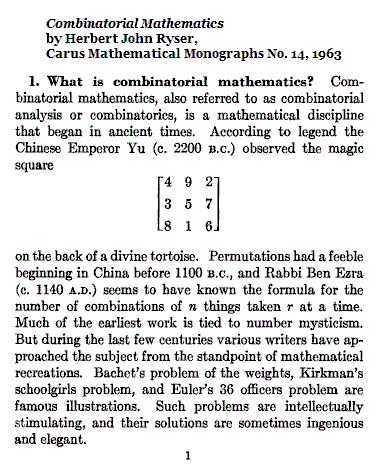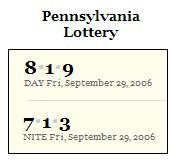Occurrences of the phrase "magic square" in Lowe-Porter's translation of the Thomas Mann novel Doctor Faustus—
"On the wall above the piano was an arithmetical diagram fastened with drawing-pins, something he had found in a second-hand shop: a so-called magic square, such as appears also in Dürer's Melancolia , along with the hour-glass, the circle, the scale, the polyhedron, and other symbols. Here as there, the figure was divided into sixteen Arabic-numbered fields, in such a way that number one was in the right-hand lower corner, sixteen in the upper left; and the magic, or the oddity, simply consisted in the fact that the sum of these numerals, however you added them, straight down, crosswise, or diagonally, always came to thirty-four. What the principle was upon which this magic uniformity rested I never made out, but by virtue of the prominent place Adrian had given it over the piano, it always attracted the eye, and I believe I never visited his room without giving a quick glance, slanting up or straight down and testing once more the invariable, incredible result."
….
"Adrian kept without changing during the whole four and a half years he spent in Leipzig his two-room quarters in Peterstrasse near the Collegium Beatae Virginis, where he had again pinned the magic square above his cottage piano."
….
" 'The decisive factor is that every note, without exception, has significance and function according to its place in the basic series or its derivatives. That would guarantee what I call the indifference to harmony and melody.'
'A magic square,' I said. 'But do you hope to have people hear all that?' "
….
" 'Extraordinarily Dürerish. You love it. First "how will I shiver after the sun"; and then the houre-glasse of the Melancolia . Is the magic square coming too?' "
….
"Here I will remind the reader of a conversation I had with Adrian on a long-ago day, the day of his sister's wedding at Buchel, as we walked round the Cow Trough. He developed for me— under pressure of a headache— his idea of the 'strict style,' derived from the way in which, as in the lied 'O lieb Madel, wie schlecht bist du ' melody and harmony are determined by the permutation of a fundamental five-note motif, the symbolic letters h, e, a, e, e-flat. He showed me the 'magic square' of a style of technique which yet developed the extreme of variety out of identical material and in which there is no longer anything unthematic, anything that could not prove itself to be a variation of an ever constant element. This style, this technique, he said, admitted no note, not one, which did not fulfil its thematic function in the whole structure— there was no longer any free note."
Review of related material—
Last night's midnight post (disambiguation), the followup 1 AM post (ambiguation), today's noon post (ambiguity), and Dürer in this journal.
The tesseracts of the noon post are related to the Dürer magic square by a well-known adjacency property.
"… the once stable 'father's depression' has been transmuted into a shifting reality that shimmered in a multiplicity of facets."
— Haim Omer, Tel-Aviv University, on Milanese ambiguation therapy,
p. 321 in "Three Styles of Constructive Therapy,"
Constructive Therapies, Vol. 2 , pp. 319-333,
ed. by Michael F. Hoyt (Guilford Press paperback, 1998)












 .
.






